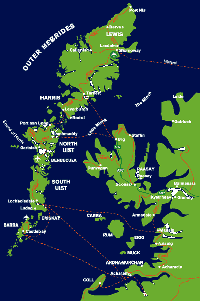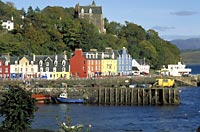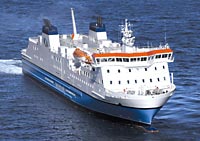The
Inner and Outer Hebrides Islands
Whisky, Weaving, Water and more
|
|
Click this map image to open up a larger map in a new window |
Although the western isles
are generally much closer to the mainland than the northern
Orkneys and Shetland Islands, they still have a very
different feel to them and seem very removed from the
mainland.
Most of the Inner Hebrides are only a short and reasonably
sheltered ferry ride away. And while the Outer
Hebrides are a slightly longer journey from the mainland,
they are definitely worth visiting too.
Part
2 of a
2 part series - click for Parts
One
Two |
There are three major island
groupings around Scotland - to the north, the Shetland and the
Orkney Islands, and to the west are the Hebrides, also known as
the Western Isles.
In total there are 790 islands,
but many are uninhabited, and only few are conveniently
reachable by visitors.
The Hebrides or Western Isles
Off Scotland’s West Coast are the Hebrides, or Western Isles -
very different in culture and atmosphere to those of the
northern ones.
A frequent service of ferries plying to and from this patchwork
of islands - mainly under the flag of Caledonian MacBrayne
(known as Calmac by the locals) make island hopping practical
and easy. They offer a variety of mountain and coastal
landscapes, and are rich in wildlife, from birds of prey to deer
and dolphins.
We'll consider the main
islands and island groupings from north to south along
Scotland's western coast.

Click this map image to open up a larger map in a new window |
The Outer Hebrides -
Lewis, Harris, North Uist, Benbecula, South Uist and Barra |
These are the northernmost islands off Scotland's west coast.
Stornaway is the major town
in the Outer Hebrides, located much of the way up the Isle of
Lewis, on its east coast. Due to the distance, air
service exists to Stornaway from Glasgow, Edinburgh and
Inverness.
If you have a short amount
of time to visit the Outer Hebrides, you might choose to travel
across by ferry from Uig on Skye to Tarbert, and then drive
north to Stornaway and around Lewis, the largest of the islands,
and then return by ferry from Stornaway to Ullapool back on the
mainland. The ferry between Uig and Tarbert is a 1 hr 40
min journey, and between Stornaway and Ullapool is a two and
three quarter hour journey.
If you have more time, you
can consider traveling to the southern islands in the group too,
and varying your ferry journeys to suit your more extensive
itinerary.
Mull, Iona, and Staffa
Oban, 93 miles north-west of Glasgow, is a compact
but bustling port from which the ferries sail off to a dozen or
more island destinations. It is a convenient stepping off
point for the Isle of Mull.
Many people chose to visit the Isle of Mull, second
largest of the Hebridean islands after Skye and a brief 40
minutes by boat. Its 352 square miles contain a population of
just 3,000 (Greater London, just under twice the size, packs in
seven million!).
Craignure, one of Mull's ferry ports, becomes a
brief hive of activity
whenever a boat arrives. After a hearty lunch in the stone-built Craignure Inn,
you might wish to climb aboard a gleaming steam
train of the Mull Railway for the mile-long ride to the
baronial-style Torosay Castle and its gardens. In typical island
fashion, visitors are welcomed as guests, encouraged to sit on
the armchairs and leaf through the family scrap albums.
Mull is one of the best islands from which to see wildlife
including sea eagles and otters, whose populations are growing
steadily. There are seals, too - and more deer than people -
plus over 200 species of birds.
In Scotland, one island often leads to another. At the western
extremity of Mull you can see Iona, with its abbey an
unmistakable landmark across the sound. As well as the regular
crossings to Iona (the journey takes about five minutes, and is
only for foot traffic not cars), two ferry companies make the longer journey
to Staffa, and you can visit both islands on the same trip.
Staffa's famous sea-cave ('Fingal's
Cave') inspired the German composer
Felix Mendelssohn to write his “Hebrides” Overture. In fact, it is not so
much an island, more a huge lump of volcanic rock rising out of
the Atlantic (its name is Norse for Pillar Island). You
can carefully edge your
way along the basaltic pillars (thankfully there is a rope to
cling to) into the mouth of the cave. It was the eerie sound of
a rough sea booming and crashing inside the cavern that inspired
the composer, though your experience may be different, with
perhaps calm sea and glorious sunshine. Chances are you'll
see puffins, shags and maybe a shy
sea-otter or two.
Visitors are invited to explore Iona on foot (cars are not
encouraged) or in style by pony-and-trap, visiting the abbey and
ancient chapel where 48 Scottish kings are reputedly buried. It
was here that St. Columba and his followers came from Ireland in
the 6th century and spread their teachings throughout Scotland
and much of Europe.
 Back on Mull, Tobermory is the main town, its focal point being
colour-washed houses strung around a crescent-shaped harbour. The rainbow-coloured town has even become the location for a BBC
children’s TV series, Balamory. The Tobermory Hotel has a room -
like so many on the islands - with a perfect view over the
harbor. Back on Mull, Tobermory is the main town, its focal point being
colour-washed houses strung around a crescent-shaped harbour. The rainbow-coloured town has even become the location for a BBC
children’s TV series, Balamory. The Tobermory Hotel has a room -
like so many on the islands - with a perfect view over the
harbor.
Tobermory is the departure point for trips to see dolphins,
basking shark and even whales, which come in close to the
islands. These are not the only delights of the Hebrides : the
air is so pure that lichen grows on the trunks and branches of
trees; and the light is so clear it gives a sharpness much
sought after by photographers and artists. Many beaches are of
soft, white sand and lapped by clear water.
Islay and Jura
The small but friendly
nature of Islay is obvious when you drive around the island -
all oncoming car drivers will give you a cheery wave.
Islay (pronounced 'Eye-Luh')
has two major points of interest. Historically, it was the
seat of the powerful 'Lords of the Isles' - the MacDonald clan.
The ruins of their main castle of Finlaggan can be visited, and while far
less impressive than an English castle, this adds to the
interest and mystery of what life was like back many hundreds of
years ago. Even less can be seen of another MacDonald
castle, Dunyvaig, located opposite the Lagavulin distillery.
Distillery? Did
someone say distillery? The other point of interest
is more current, although it too has a long history.
Whisky. Islay is currently home to seven operating
distilleries, and these seven distilleries are renowned
throughout the world of whisky drinkers for their very
distinctive whisky. They are smokey and peaty, and also
have a strong seaweed type aroma, doubtless imbued into the
whisky as it lies maturing in barrels close to the water's edge.
A visit to one or two (or
three or four....) of the distilleries is definitely something
you should include during your stay on Islay. Three are
almost immediately adjacent to each other (Laphroig,
Lagavulin and
Ardbeg), two others are not far from each other (Caol Ila
and
Bunnahabhain), one is centrally located in the town of
Bowmore (Bowmore)
and the seventh is by itself (Bruichladdich).
They are all no more than 15 - 30 minute drive apart from each
other.
Jura is a five minute ferry
ride from Islay. It has 'only' one distillery, and is
sparsely populated. It is best known for its distinctive
hills and for its one-time resident, George Orwell, who came to write "1984".
Getting to Islay and Jura
Ferries travel from the
mainland to two ports on Islay - Port Ellen and Port Askaig.
It doesn't really matter whether you choose to take the ferry to
one or the other destination, because Islay is small, and the
chances are you won't actually stay at either port, but instead
will stay in Islay's main town of Bowmore.
It is a two hour crossing
between Kennacraig on the mainland and Port Askaig, and a
similar duration from Port Ellen.
Where to stay on Islay
There are three main hotels
on Islay, plus other smaller hotels and guest houses. The
three main hotels are :
Harbour
Inn - Located in downtown Bowmore, and with a good
reputation for food.
Lochside Hotel - Located just around the corner from the
Harbour Inn, this is perhaps half a star down in quality, but
has a friendly more personal feel to it, and boasts the largest
range of malt whiskies of anywhere on Islay in their bar.
Port Charlotte Hotel - A very nice hotel, but located in
Port Charlotte rather than Bowmore, so not quite as central to
the various things you'll be wanting to see and do on Islay.
Skye
Skye is the largest of the
islands off Scotland's coast. Often associated with
'Bonnie Prince Charlie' and the song that recounts his escape to
Skye by boat, Skye is now connected by a
bridge to the mainland. This was a controversial act, as many of the
islanders feared losing their special island identity.
They need not have worried - Skye retains its own unique appeal.
Ferries also provide service
from Mallaig over to Armadale across the Sound of Sleat.
This is a beautiful and short 30 minute crossing.
The main town on Skye is
Portree.
Getting to and around
the Western Isles of the Hebrides
 Ferry
schedules are seasonal, with the most frequent services being
operated in the summer (ie April - October), and some ferries not operating at all in
the winter. Ferry
schedules are seasonal, with the most frequent services being
operated in the summer (ie April - October), and some ferries not operating at all in
the winter.
Most West Coast ferry services are run
by Caledonian MacBrayne.
You can buy individual tickets, and they also offer Island Rover
passes. These give you the run of the 22 islands they
serve for
eight (or 15) days. 2004 prices range from £47.50 (£69) per person to
£228 (£341) per car; bicycles travel free. Fares will
increase by 2.5% on 25 March, 2005.
The island of Skye is now
connected to the mainland by a toll bridge.
Smaller Ferry Services in the
Hebrides
There is a small passenger
only ferry with seasonal service between
Portree on the Isle of Skye and Gairloch (not very far from
Ullapool) on the mainland (a 90 minute journey).
There is a small car and
passenger ferry that travels every 20 minutes or so the short
distance between
Gourock and Dunoon. This is a bit west of Glasgow.
There is a small car and
passenger ferry that offers service every 30 minutes or so
between
Islay and Jura.
For more information
More information on The
Hebrides is available from their
visitor
information website.
Read more in Part 1
In
Part 1 we look at the islands
north of Scotland - the nearby Orkney Islands and the distant
Shetland Islands.
Related Articles, etc
|
If so, please donate to keep the website free and fund the addition of more articles like this. Any help is most appreciated - simply click below to securely send a contribution through a credit card and Paypal.
|
Originally published
3 Aug 2004, last update
30 May 2021
You may freely reproduce or distribute this article for noncommercial purposes as long as you give credit to me as original writer.
|

